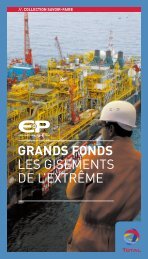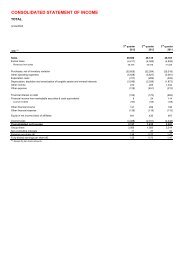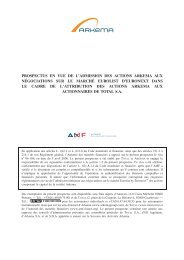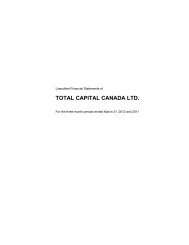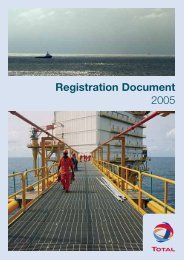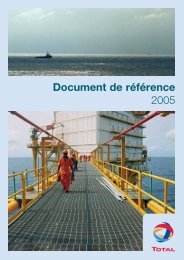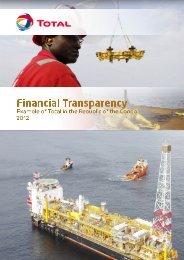Registration document 2007 - Total.com
Registration document 2007 - Total.com
Registration document 2007 - Total.com
You also want an ePaper? Increase the reach of your titles
YUMPU automatically turns print PDFs into web optimized ePapers that Google loves.
equal to the market price. For unlisted securities, if the fair value<br />
is not reliably determinable, securities are recorded at their<br />
historical value. Changes in fair value are recorded in<br />
shareholders’ equity. If there is any evidence of a significant or<br />
long-lasting loss, an impairment loss is recorded in the<br />
consolidated statement of in<strong>com</strong>e. This impairment is only<br />
reversed in the statement of in<strong>com</strong>e when the securities are sold.<br />
(iii) Derivative instruments<br />
The Group uses derivative instruments in order to manage its<br />
exposure to movements in interest rates, foreign exchange rates<br />
and <strong>com</strong>modity price fluctuations. Changes in fair value of<br />
derivative instruments are recognized in the statement of in<strong>com</strong>e<br />
or in shareholders’ equity and are recognized in the balance<br />
sheet in the accounts corresponding to their nature, according to<br />
the risk management strategy described in note 29 to the<br />
consolidated financial statements. The derivative instruments<br />
used by the Group are the following:<br />
- Cash management<br />
Financial instruments used for cash management purposes are<br />
part of a hedging strategy of currency and interest rate risks in<br />
reference to global limits set by the Group and are considered to<br />
be used for transactions (held for trading). Changes in fair value<br />
are systematically recorded in the in<strong>com</strong>e statement. The<br />
balance sheet value of those instruments is included in “Current<br />
financial assets” or “Other current financial liabilities”.<br />
- Long-term financing (other than euro)<br />
When an external long-term financing is set up, specifically to<br />
finance subsidiaries in a currency other than the euro, which is<br />
mainly the case for subsidiaries whose functional currency is the<br />
dollar, and when this financing involves currency and interest rate<br />
derivatives, these instruments qualify as fair value hedges of the<br />
interest rate risk on the external debt and of the currency risk of<br />
the loans to subsidiaries. Changes in fair value of derivatives are<br />
recognized in the in<strong>com</strong>e statement as are changes in fair value<br />
of financial debts and loans to subsidiaries.<br />
The fair value of those hedging instruments of long-term<br />
financing is included in the assets under “Hedging instruments on<br />
non-current financial debt” or in the liabilities under “Non-current<br />
financial debt” for the non-current part. The current part (less<br />
than one year) is accounted for in “Current financial assets” or<br />
“Other current financial liabilities”.<br />
In case of the anticipated termination of derivative instruments<br />
accounted for as fair value hedge, the amount paid or received is<br />
recognized in the in<strong>com</strong>e statement and:<br />
• If this termination is due to an early cancellation of the hedged<br />
items, the adjustment previously recorded as revaluation of<br />
those hedged items is also recognized in the in<strong>com</strong>e<br />
statement.<br />
• If the hedged items remain in the balance sheet, the<br />
adjustment previously recorded as revaluation of those<br />
hedged items is spread over the remaining life of those items.<br />
Appendix 1 – Consolidated financial statements<br />
Notes to the consolidated financial statement<br />
- Foreign subsidiaries’ equity hedge<br />
Certain financial instruments hedge against risks related to the<br />
equity of foreign subsidiaries whose functional currency is not the<br />
euro (mainly dollar). They qualify as “net investment hedges”.<br />
Changes in fair value are recorded in shareholders’ equity.<br />
The fair value of these instruments is recorded under “Current<br />
financial assets” or ”Other current financial liabilities”.<br />
- Financial instruments related to <strong>com</strong>modity contracts<br />
Financial instruments related to <strong>com</strong>modity contracts, including<br />
all the crude oil, petroleum products, natural gas and power<br />
purchasing/selling contracts related to the trading activities,<br />
together with the <strong>com</strong>modity contract derivative instruments such<br />
as energy contracts and forward freight agreements, are used to<br />
adjust the Group’s exposure to price fluctuations with reference<br />
to global trading limits. These instruments are considered,<br />
according to the industry practice, as held for trading. Changes<br />
in fair value are recorded in the in<strong>com</strong>e statement. The fair value<br />
of these instruments is recorded in the appropriate operating<br />
third party headings “Accounts receivable and other current<br />
assets” or “Accounts payable and other creditors” depending on<br />
whether they are assets or liabilities.<br />
Detailed information about the closing balances is disclosed in<br />
notes 20, 27 and 29 to the consolidated financial statements.<br />
(iv) Current and non-current financial liabilities<br />
Current and non-current financial liabilities (excluding derivatives)<br />
are recognized at amortized cost, except those for which a<br />
hedge accounting can be applied as described in the previous<br />
paragraph.<br />
(v) Fair value of financial instruments<br />
Fair values are estimated for the majority of the Group’s financial<br />
instruments, with the exception of publicly traded equity<br />
securities and marketable securities for which the market price is<br />
used.<br />
The estimation of fair values, based in particular on principles<br />
such as discounting to present value of future cash flows, must<br />
be weighted by the fact that the value of a financial instrument at<br />
a given time may be modified depending on the market<br />
environment (liquidity especially), and also the fact that<br />
subsequent changes in interest rates and exchange rates are not<br />
taken into account. In some cases, the estimates have been<br />
made based on simplifying assumptions.<br />
As a consequence, the use of different estimates, methodologies<br />
and assumptions may have a material effect on the estimated fair<br />
value amounts.<br />
The methods used are as follows:<br />
9<br />
• financial debts, swaps: the market value of swaps and of<br />
debenture loans that are hedged by those swaps, have been<br />
determined on an individual basis by discounting future cash<br />
TOTAL – <strong>Registration</strong> Document 2006 177




